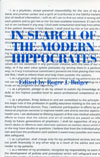Sickness, Recovery, and Death
"…this wide-ranging volume usefully lays out the issues and provides a first survey of the relevant historical record."—Science
"This book is at once fascinating and exasperating…if you like to argue with a provocative author, your copy will be as full as mine is with marginal notes of agreement and disagreement. But that is what stimulating writing, new information, and incisive analysis are all about."—Journal of the American Medical Association
Like many other organisms, the human species faces a boundary of survival, a maximum potential life span that can be shown on a graph. Yet people in all age groups die of causes as different as heart disease and freak accidents. This historical exploration into sickness—and, most specifically, its outcome—gives us a perspective on the human life span, past and recent patterns of sickness and recovery, and a projection of what the future of human trends will be.
Using data from records of sick funds for the previous two centuries, more conventional public records and case histories in the past century, and the beliefs and assumptions about sickness that are common to us all, James C. Riley provides a comprehensive look at ill health in Europe and North America from the seventeenth century to the present. While mortality has declined over the past three hundred years—in the twentieth century, death has been pushed into the realm of the old—ill health rates show a surprisingly independent trend. Before 1870 they fluctuated, depending on exposure to disease, the age of the population, and other factors. Since about 1870, ill heath rates have increased, and more increase is projected for the future.
This cross-disciplinary integration of history, medicine, and biology will prove valuable for students of medical history as well as epidemiologists, gerontologists, demographers, and social historians.






